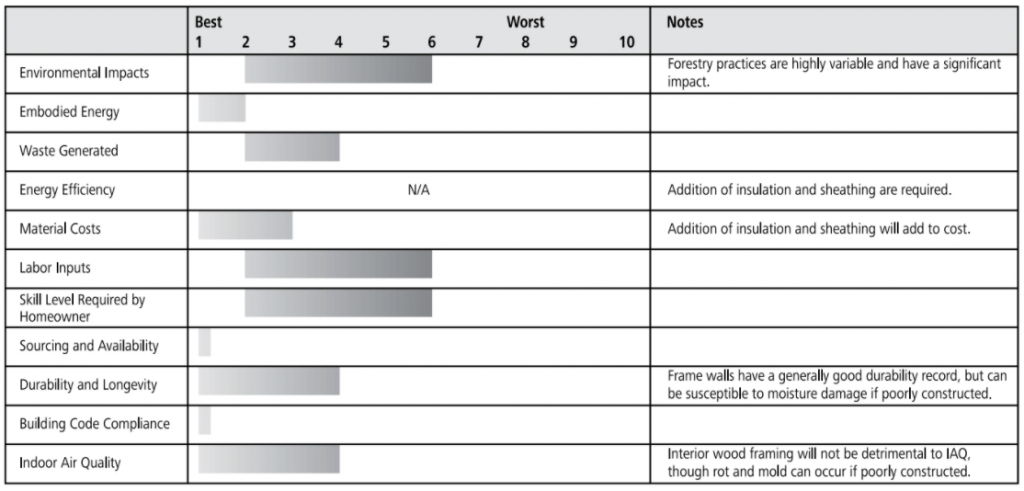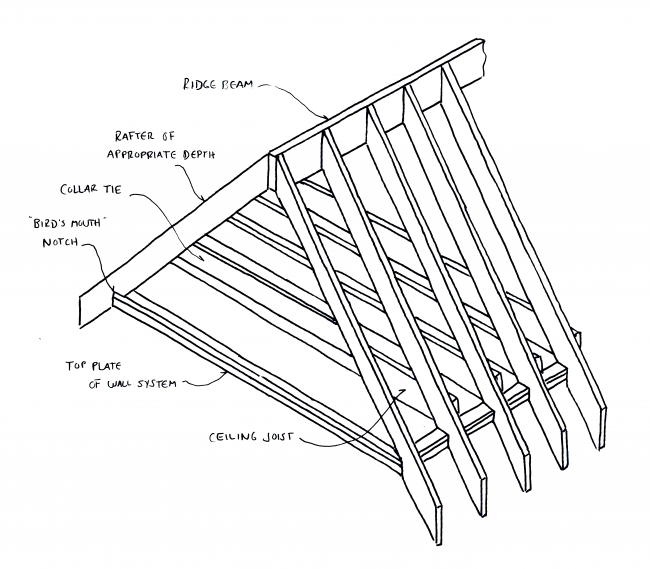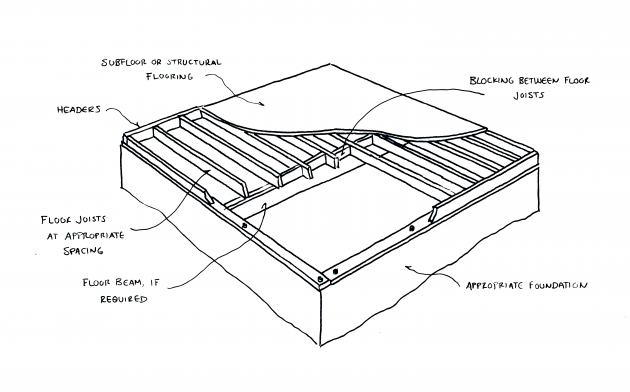wood Framing
Floor & Roof structure: MATERIALS ENCYcLOPEDIA
Applications for this system
Roof framing systems
Suspended floor systems
Basic materials
Dimensional lumber
Fasteners, hangers and/or bracing
Ratings Chart for Wood Framing

The ratings chart shows comparative performance in each criteria category. Click on the tabs below for detailed analysis of each criteria.
- HOW THE SYSTEM WORKS
- ENVIRONMENTAL IMPACTS
- WASTE
- EMBODIED CARBON
- ENERGY EFFICIENCY
- MATERIAL COSTS
- LABOUR INPUT
- SKILL LEVEL REQUIRED
- SOURCING & AVAILABILITY
- DURABILITY
- CODE COMPLIANCE
- INDOOR AIR QUALITY
- RESOURCES
- FUTURE DEVELOPMENT
Wood framing System


Timber is sawn to standard dimensions (2×4, 2×6, 2×8, 2×10, 2×12) and dried to code-approved levels. An appropriate dimension of lumber is chosen to meet specific span requirements. Lumber is cut to suit the application and fastened in place at a specified spacing (usually 12, 16 or 24 inches / 300, 400 or 600 mcm on center).
Environmental Impact Rating
Harvesting — Negligible to High
Wood harvested from the building site or the local region can have negligible impacts. Unmanaged forestry can have impacts that include significant habitat destruction, soil erosion and ground water contamination. Third-party certification can help to ensure that impacts are minimized.
Metal fasteners may seem like a small component, but dozens of kilograms can go into a frame wall. Ore for steel production is mined in an intensive process with impacts including habitat destruction and soil and water contamination.
Manufacturing — Negligible to Moderate
The sawing and planing of structural lumber is a relatively low–impact mechanical process.
Processing raw ore into nails and screws is a multi-stage and intensive process requiring multiple infusions of high heat and fossil fuel use with impacts including air and water pollution.
Transportation — Negligible to High
Sample building uses 2,619 kg of lumber for roof and floor:
3.9 MJ per km by 15 ton truck
2.5 MJ per km by 35 ton truck
Timber is a heavy and high-volume material and accrues significant impacts proportional to distance traveled. In most regions it is possible to source lumber a reasonable distance from the building site.
Installation — Negligible to Moderate
The number of offcuts from a wood frame wall can be quite high. Careful cut lists and ordering can minimize this waste.
Waste: moderate
Compostable: Wood offcuts.
Recyclable: Metal fasteners.
Landfill: Wood impregnated with fasteners, lumber tarps.
Chart of Embodied energy & carbon
wood-framed floor:
wood-framed roof:
Energy Efficiency: n/a
A distinct thermal control layer is required for framed roof and floor assemblies. The insulation materials covered in Chapter 2: Walls are all feasible in framed roofs and floors. The depth of the framing members used may determine the amount of insulation that can be added and should be considered carefully. If framing members are not large enough to provide adequate thermal control, consider strapping or furring to provide additional insulation depth and reduce thermal bridging.
Material costs: Low to moderate
Labour Input: moderate
Floor framing is usually straightforward, with a minimum of cutting and fitting required to complete a floor system.
Roof framing will vary greatly depending on design. A simple shed roof is almost as straightforward to frame as a floor system, but a roof with many pitch changes and/or hips and valleys can be very complex. Labor input will depend greatly on design.
Skill level required for homeowners: moderate
For beginners, a wide range of resources is available to help learn how to frame, from books to hands-on courses. Beginners should be able to undertake simple framing projects, but may want to hire professional help if the project is complex or timelines are tight.
Sourcing & availability: Easy
Framing lumber is widely available through major building supply centers. Local mills exist in most areas with forests, but may require effort to locate.
Third-party certification programs will have resources available to direct purchasers to outlets for wood bearing their certification.
Durability: High
Wood framing has proven itself to be a durable approach over the past hundred and fifty years. Though wood can be prone to rot, mold and insect infestation, strategies to avoid all of these problems are well understood and employed and the majority of wood-framed structures have a long lifespan.
For roof framing, the quality and condition of the sheathing above will determine the durability of the framing. Leaky roofs will cause rapid deterioration of roof framing components.
Code compliance
Wood frame construction is prescribed in all building codes, which will provide span charts to cover wood usage in most residential flooring and roof systems.
Indoor air quality: n/a
Structural roofing systems won’t have a direct impact on indoor air quality, as the material is outside the living enclosure and separated by air, vapor and thermal control layers as well as finishes.
Interior floor systems, though covered with finishes, occupy space inside the building enclosure. Wood is generally considered to be a natural and benign material with little effect on air quality.
Resources for further research
Thallon, Rob. Graphic Guide to Frame Construction: Details for Builders and Designers. Newtown, CT: Taunton, 2000. Print.
Simpson, Scot. Complete Book of Framing: An Illustrated Guide for Residential Construction. Kingston, MA: RSMeans, 2007. Print.
Newman, Morton. Design and Construction of Wood-Framed Buildings. New York: McGraw-Hill, 1995. Print.
Burrows, John. Canadian Wood-Frame House Construction. Ottawa, ON: Canada Mortgage and Housing Corporation, 2006. Print.
Future development
Wood framing has not changed much in the past half century, and is unlikely to undergo any major changes in the future. It is well understood and well used throughout the construction industry.
The greatest change has been the development of third-party sustainability certification programs. Many major timber companies and lumber retailers have been adopting these programs and making certified lumber easier to obtain. While there is debate about the value of some certifications, this movement has been an important development in the greening of the forestry industry.
The development of high-quality, portable sawmills has created a rise in the number of sawyers working on a small scale. Many North American forests have been clear-cut several times, and the regrowth of these forests suits the scale of the small woodlot sawyer. In many regions, growth in the number of small mills will create greater access to this resource.
Tips for successful wood framing
1. Choose a good source for framing lumber. Locally, sustainably harvested wood is available in many places, as is third-party certified wood.
2. Choose good quality wood. The effectiveness of the floor or roof system will depend greatly upon the quality of the wood, as will the amount of labor required. Wood that is warped, cupped, split or otherwise flawed will make it harder to do the framing and compromise the results. Many codes require lumber to be “grade stamped” to ensure quality, but this is not always a guarantee of good lumber.
3. Consider the span charts in local codes carefully. Sometimes significant savings can be made in the amount and size of lumber needed by adjusting designs by a small amount.
4. A great deal of excellent literature exists to assist with framing projects and should be referenced before beginning a project.





